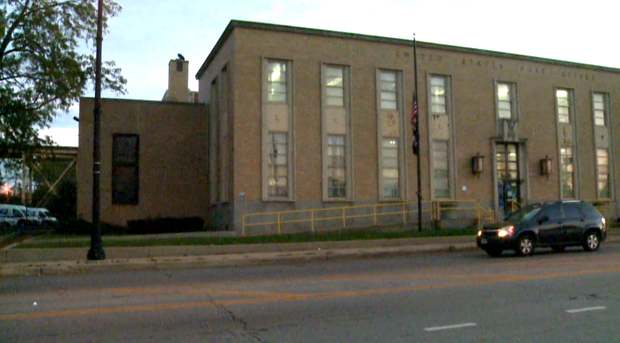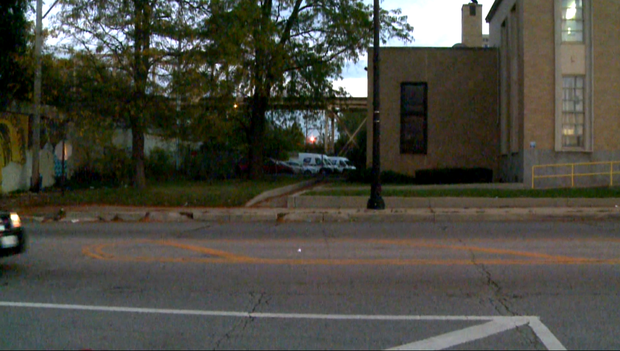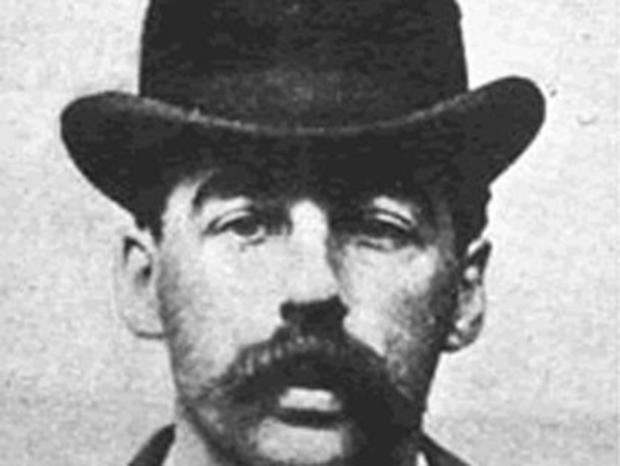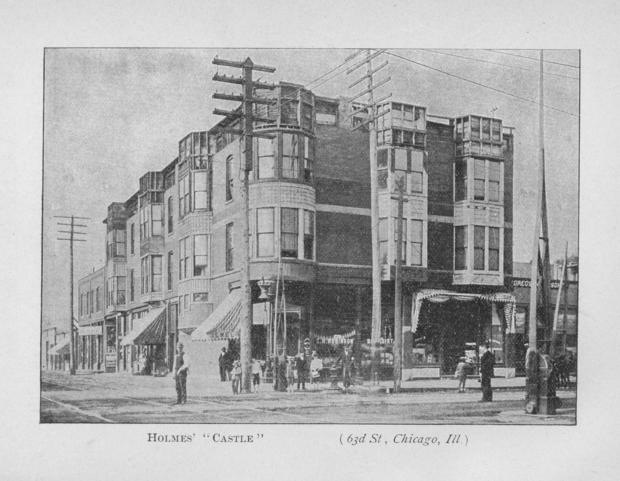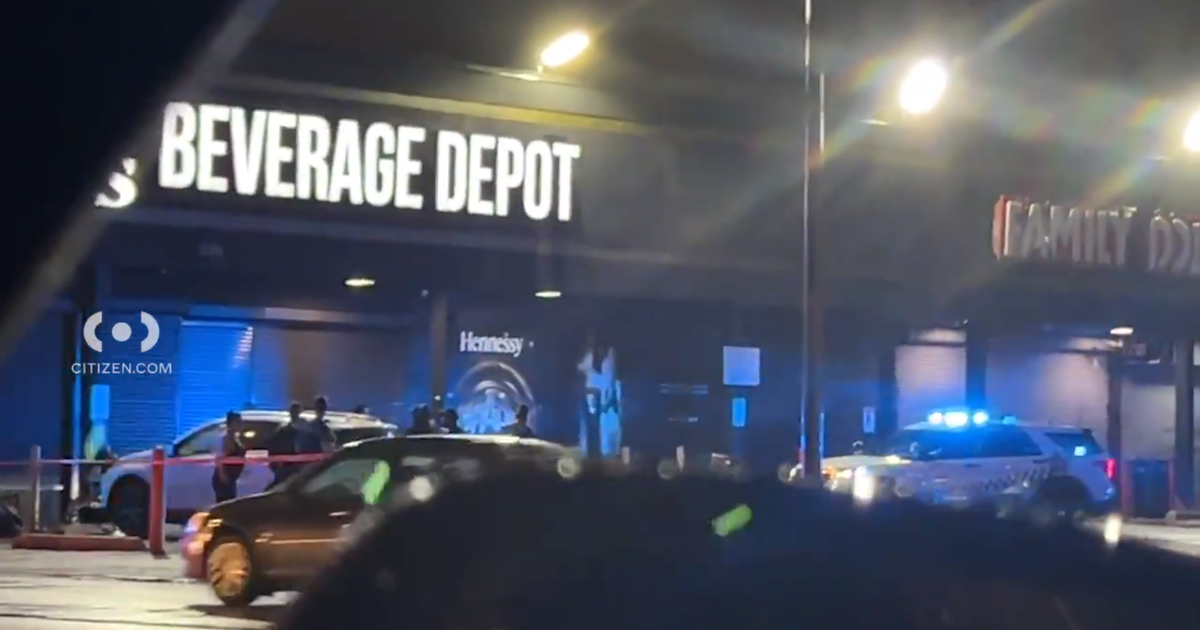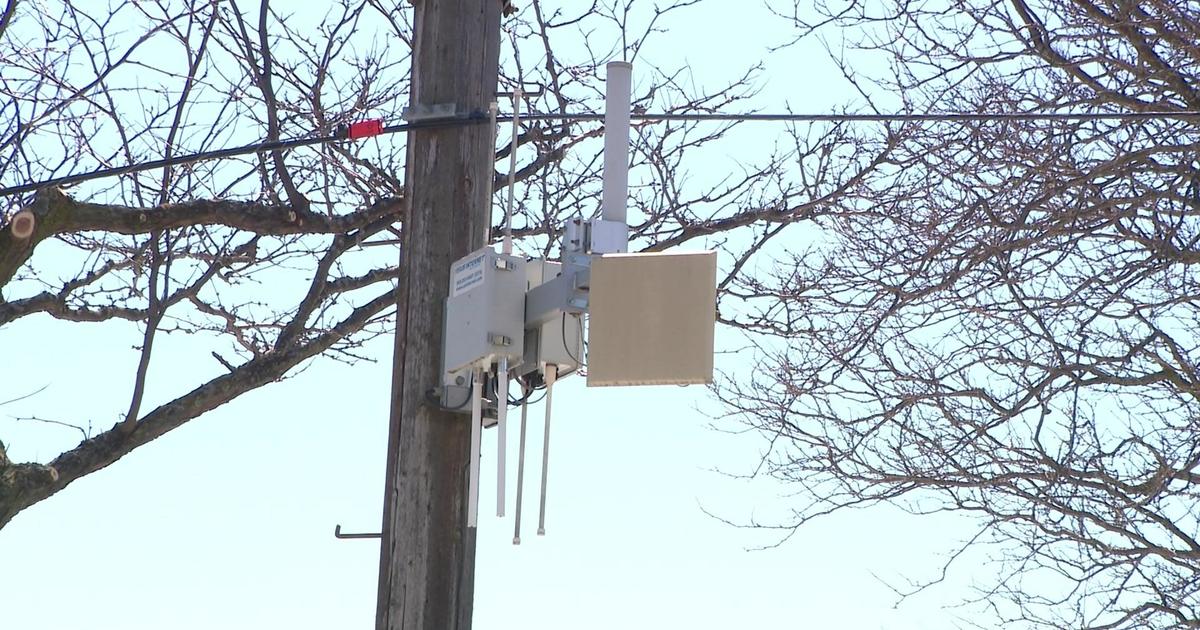Chicago Hauntings: The Story Of H.H. Holmes' Murder Castle, And Sightings In The Basement Of The Englewood Post Office Standing In Its Place
CHICAGO (CBS) -- If you go to the corner of 63rd and Wallace streets in the Englewood community today, you will find a U.S. Post Office.
The Post Office is a modest, somewhat institutional yellow brick building – one of many built during the New Deal era under President Franklin Delano Roosevelt. The Chicago Transit Authority Green Line runs on an elevated trestle just behind the Post Office, while a weathered concrete freight train embankment runs just to the east. An eagle carved in stone hangs over the front doors of the Post Office, while a sign with three yellow triangles in a once-black, now faded blue circle next to the doors evokes a past time of menacing uncertainty – denoting a fallout shelter in the building.
We'll get back to the Englewood Post Office. This story is mainly about the building that stood there before the Post Office was built.
The Post Office does not stand perfectly on the footprint of that earlier building. Tony Szabelski of Chicago Hauntings Ghost Tours says it would have encompassed the eastern part of the present-day Post Office footprint, and the grassy knoll that separates the Post Office from the freight train embankment.
That earlier building is most infamously known as the Murder Castle. We don't know exactly how many people H.H. Holmes – one of America's first serial killers – murdered in the building around the time of the World's Columbian Exposition a few miles to the east in Jackson Park in 1893. But its horrors are the stuff of legend, albeit subject to a challenging task of separating fact from myth.
The Crime Museum tells us H.H. Holmes was born Herman Webster Mudgett in New Hampshire. He graduated from high school early and attended medical school at the University of Michigan – where the Crime Museum says the story is he stole cadavers from the school's laboratory, disfigured or burned them, and then planted the bodies to suggest they'd been killed in accidents – while taking out insurance policies on the deceased people in question and collecting the money.
Holmes moved to Chicago around 1885 after finishing medical school, and began working at a pharmacy under the name Dr. Henry Howard Holmes, the Crime Museum tells us. The pharmacy appears to have been located on the northwest corner of 63rd and Wallace streets, where an Aldi store with a vast parking lot can now be found.
The commonly-heard story goes that the drugstore was owned by an elderly man with terminal cancer named Dr. E.S. Holton, whose wife took over the store when he died. Holmes went on to buy the store from Dr. Holton's wife, the legend claims. Mrs. Holton disappeared, and Holmes claimed to everyone that she'd moved to California – and she was never heard from again, the story goes. The implication is that most believed Holmes probably killed her.
But in a 2013 article, Adam Selzer of Mysterious Chicago reports some aspects of this tale are not accurate. He reported it turns out that Dr. E.S. Holton was not Mr. Holton, but Mrs. Holton – the initials stood for Elizabeth Sarah. Dr. Holton and her husband, William, also actually outlived Holmes by several years and were still living in Chicago after Holmes was executed – the old pharmacist dying of cancer was a myth that was apparently spread by Holmes himself, Selzer reports.
What is known is that Holmes did take over the pharmacy, and had the building that became known as the Murder Castle constructed across the street between 1889 and 1891. The Crime Museum reports Holmes hired and fired numerous crews during the construction period so they wouldn't be able to figure out what he was really up to with the building.
The building was originally two stories high – with storefronts including a drugstore on the ground floor, and apartments above. Holmes went on to add a third story.
Once the building was completed, the story goes that Holmes began placing classified ads for jobs for young women, as well as advertising the hotel as a place to stay. The story goes that hotel employees and guests were also required to have life insurance policies, and Holmes himself paid the premiums provided that they list him as the beneficiary, according to the Crime Museum account.
Soon afterward, many women started disappearing, the story goes.
When the World's Fair came to Chicago – drawing tourists from around the world – the story goes that Holmes' Castle was billed as the World's Fair Hotel.
Inside Holmes' castle, the story goes that the rooms could not be locked from the inside of the room – only outside. Meanwhile, everything back in those days was lit with gas lamps, and the story goes the connections to the gas lamps were outside the room – set up such that Holmes could turn on the gas and asphyxiate people at will.
Szabelski notes that there were reports that the building also had a lot of strange oddities to it when it was built. There were doors and stairwells that led to nowhere, and hidden and closed rooms throughout the building. Stories claim that parts of the walls moved, and there were chutes that led down to the basement. In a December 1943 article for Harper's Magazine, writer John Bartlow Martin used most gruesome terms to describe that basement:
"The cellar was perhaps the most remarkable section of the building. It was fitted with operating tables, a crematory, pits containing quicklime and acids, surgical instruments, and various pieces of apparatus which, resembling mediaeval torture racks, never were satisfactorily explained. (Some thought Holmes used these appliances to wring from his victims the whereabouts of their wealth; others said he used them in experiments which he hoped would prove his pet theory that the human body could be stretched indefinitely, a treatment that, ultimately, would produce a race of giants.) Holmes sometimes destroyed the bodies of his victims completely; sometimes, aided by a needy skeleton articulator who answered his advertisement in the paper, he stripped the flesh from their bones and sold the skeletons to medical institutions."
However, Selzer reports in his book, "H.H. Holmes, The True Story of the White City Devil", that some of these stories amount to so much mythology. While reports say Holmes told investors he planned to use the building as a hotel for World's Fair guests, Selzer writes the castle never actually went into operation as a fully-functioning hotel at all. Selzer also writes the secret chambers in the building really served the purpose of hiding stolen furniture rather than disposing of bodies.
Selzer also reports that only one of Holmes' victims was known to be a tourist visiting the World's Fair. And as to those elaborate torture chambers and other architectural horrors, Harold Schecter, author of the book "Depraved: The Definitive True Story of H.H. Holmes, Whose Grotesque Crimes Shattered Turn-of-the-Century Chicago," chalks them up in a History.com article to the sensational yellow journalism of the era in which details were sometimes concocted.
There are claims that Holmes killed as many as 200 people - though Selzer told History.com that this claim is a "throwaway line" that does not have a basis in fact. Holmes confessed to 27 murders, but even that figure is dubious, inasmuch as some of the people he claimed to have murdered were actually still alive, Selzer told History.com.
Szabelski notes the story goes were at least nine or 10 people who we know would have been last seen with Holmes in the so-called Murder Castle, and who were never seen again.
Holmes later left Chicago and found his way to Texas and then to St. Louis, where he was arrested and jailed for a swindling operation involving the sale of stolen horses, the story goes. While in jail, the story goes that Holmes engaged his cellmate – Wild West outlaw Marion Hedgepath – to set up an insurance scam where Holmes would take out a $10,000 policy on his own life and then fake his own death.
Holmes tried to take out the policy after being released on bail, but the insurance company became suspicious – so Holmes instead went to Philadelphia and concocted a similar scheme in which his longtime business partner, Benjamin Pitezel, would be the one to fake his own death, the story goes. But Holmes actually killed Pitezel, and went on to kill Pitezel's three children. The bodies of daughters Alice and Nellie were found buried in Toronto, and the body of son Howard in Indianapolis, multiple accounts say.
Holmes was tried and convicted of Ben Pitezel's murder, and was hanged in a public execution at Moyamensing Prison in Philadelphia on May 7, 1896.
So of course, you wanted to know about ghost stories. Many people say the basement of the Post Office that now occupies the Murder Castle site can be very creepy, Szabelski tells us. They report hearing sounds or seeing shadow figures.
There is a portion of the basement of the current building that crosses over to a section that would be underneath the grassy area to the east. That section of the basement reportedly looks much older, and many people believe it would have been part of the original basement for Holmes' murder castle.
Finally, there's the question of what became of the murder castle after Holmes left it behind. Most reports say after a police investigation was completed at the building, someone named A.M. Clark took it over with plans to turn it into a macabre museum. Many reports say soon after that – in 1895, sometime before Holmes was executed – the building burned to the ground.
The second part is not true. Selzer points out in his book that while there was a fire that damaged the building at that time, the upper two floors were rebuilt afterward – and the building remained until it was finally torn down in the 1930s to make way for the Post Office.
The story of Holmes and the Murder Castle reentered the popular conscience in 2003, when Erik Larson's book, "The Devil in the White City," became a bestseller.
Video produced by Blake Tyson. Written story by Adam Harrington.
